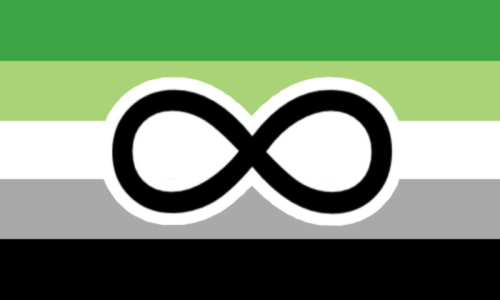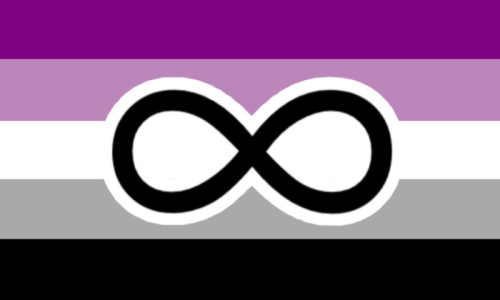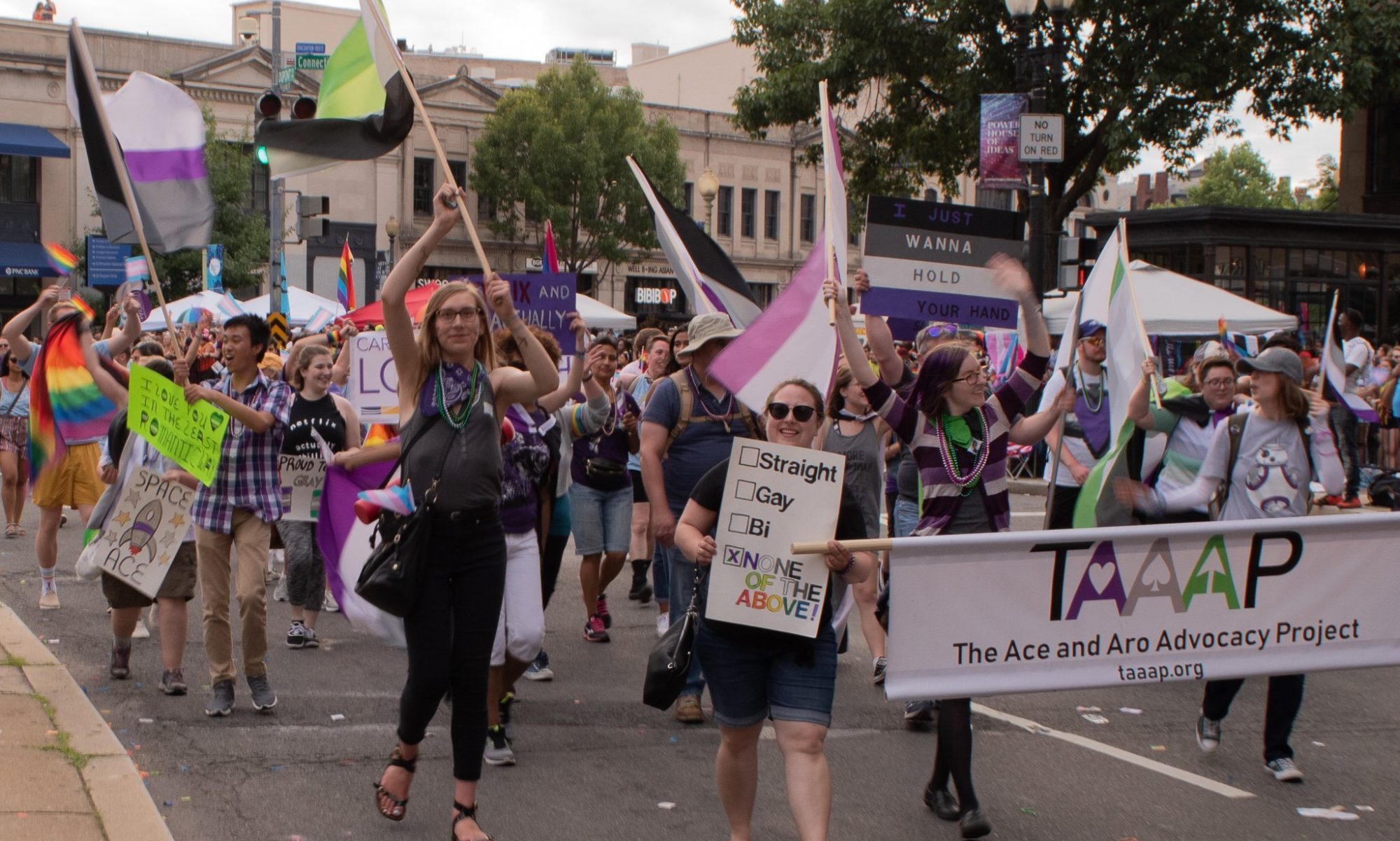CW: mentions of ABA, conversion therapy, abuse, aphobia, ableism
In the US, April is Autism Acceptance Month; globally, April 2 is World Autism Awareness Day. That makes this month the perfect time to learn more about the experiences of autistic aspecs!
Before we begin, a note on terminology. Many queer autistic people do not separate their orientation and/or gender from their neurodivergences, and that applies to aspec identities. They might identify as autiaro and/or autiace. Others might use separate labels for their sexual and/or romantic identities and their autistic identity. This post will use the term “autistic aspecs” to encompass all people who hold both an autistic and one or more aspec identities.




Prior research has suggested that, on average, autistic people tend to be queer at a greater percentage than allistic (non-autistic) people. George & Stokes (2018) found that nearly 70% of their autistic study participants identified as non-heterosexual, in contrast to only 30% of the allistic participants. However, while this study used the Sell Scale of Sexual Orientation – a model that technically acknowledges the existence of asexuality – it does not account for ace-spec identities like demisexual or greysexual, nor does it include romantic orientations (including aromanticism) at all. It also does not clearly represent aspec people who also identify as heterosexual, such as heterosexual aros or demisexual heterosexuals. So, while this study does indicate that a high percentage of autistic people are queer, it does not fully represent the autistic aspec community.
There has been little research investigating autism and asexuality specifically – and none at all investigating autism and aromanticism. In one study that did focus on autism and asexuality, Ronis et al (2021) used both self-report measures and the more objective measure of the Asexual Identification Scale (AIS) to study asexuality among autistic people with low support needs. The different measures provided information that sometimes seemed conflicting – pointing to a need for better tools to both educate autistic people about asexuality and measure its prevalence. 2.4% of participants both identified as ace and reported no sexual attraction on the AIS; this number is certainly an undercount, as it excludes aces who feel any level of sexual attraction. The study also excludes autistic people with high support needs. Approaching this overlap in a different way, 17.5% of 2019 Asexual Community Survey respondents – in other words, more than one in six – identified as autistic (Weis et al, 2021).
Some researchers and community members have explored possible reasons why autism and asexuality can, for some people, be related. Some scholars are interested in exploring genetic or hormonal causes for the overlap between aspec identities and autism; however, this approach risks medicalizing and pathologizing both identities. Another idea is that because autistic people are more likely to not conform to social norms we perceive to be arbitrary, we are less likely to limit ourselves to the most widely known orientations, instead continuing to explore labels until we find the ones that truly fit. Some autistic people also connect their sexual or romantic identity/ies to sensitivities around touch, though this connection is not universal (for example, someone can be hyposensitive to touch and sex-averse, or hypersensitive to touch and sex-favorable, or other combinations).
Understanding the experiences of autistic aspecs goes beyond exploring the potential causes for the overlap between being autistic and ace or aro; autistic aspecs face unique challenges based on how the two groups are treated and understood in our society. Stereotypes and misconceptions about aspec identities – such as social awkwardness for aces and emotional coldness for aros – are often applied to autistic people as well. Autistic people are also often infantilized and desexualized, with allistics perceiving us as being incapable of understanding the nuances of social behavior as it relates to sex or romance, or even being unable to consent. These misconceptions lead allistic people to falsely assume that all autistic people are ace. Additionally, because autistic people do not outwardly display emotions in allistic ways, allistic people assume that we either lack the ability to emotionally regulate or the ability to feel emotion altogether. Allistic people extend these misconceptions to the realm of romance and falsely assume that all autistic people are aro. All of these false assumptions perpetuate harmful stereotypes about aromanticism, asexuality, and autism. In turn, many autistic people push back against these assumptions by emphatically attempting to separate autism and asexuality/aromanticism, veering into aphobia in the process.
The autistic and aspec communities also share another parallel form of oppression in the way that allistic and allonormative societies try to change them. Applied Behavior Analysis is a widely-used autism “treatment” that uses behavioral conditioning to force autistic people to suppress their autistic traits; within the autistic community, ABA is known to be deeply traumatic and violently harmful. The founder of ABA, Ole Ivar Lovaas, was also heavily involved in the establishment of conversion therapy – a similarly traumatic and violent “treatment” for queer people, including aspecs, that intends to force people to be cis, heterosexual, and heteroromantic. More broadly, both autistic people and aspec people are often wrongly pathologized – sometimes even by aspec communities and autistic communities respectively.
Ableism and aphobia sometimes overlap and sometimes duel, but in both cases, this interaction can make it hard for autistic aspecs to understand their identities. When the two communities try to distance themselves from each other, those of us caught in the middle might doubt or even reject one of the identities, or it might take us longer to figure out one or more identities. For example, people who discover their autistic identity first may worry that they would be confirming stereotypes about autism if they were aspec, and so they place additional pressure on themselves to conform to allonormative expectations.
Autistic aspec people are also impacted by amatonormativity and compulsory sexuality in a unique way. Many autistic people implicitly learn to camouflage (or mask) their autistic traits, consciously or subconsciously putting on an allistic “mask” in order to blend in. For autistic aspecs, amatonormativity and compulsory sexuality can be part of the allistic-normative world. Before coming out to ourselves, many aspecs (autistic and allistic) experience the feeling of “everyone is exaggerating about their sexual/romantic attraction”; for autistic aspecs, performing allosexuality and alloromanticism can be part of an allistic mask, and extremely complicated to untangle from from other aspects of masking. This can make it harder for autistic people, including autistic people who do not yet know that they are autistic, to realize that they are aspec.
Autistic aspecs also experience unique dangers in the realm of dating and relationships. Autistic people can be particularly vulnerable to abuse; this vulnerability can manifest in a specific way for autistic aspecs. For example, allo partners can take advantage of autistic aspecs, manipulating them into romantic or sexual situations in ways that prey on the eagerness to please, struggle to read others, alexithymia, and/or other qualities common among autistic people.
While much of this post has focused on the challenges facing autistic aspecs, that does not mean that our experiences are entirely informed by these challenges. There are a sizable number of us who hold both autistic and aspec identities; in autistic spaces, you’re likely to meet other aspecs, and vice versa in aspec spaces. This means that an autistic aspec community is out there for you to find. Additionally, knowing yourself is often empowering, even if it takes the hard work of unlearning a great deal of societal messaging in the process. Autistic aspecs, you are not alone, you are not responsible for confirming or perpetuating stereotypes about these identities, and your identities and experiences are worthy of respect.
Further Reading and Viewing
- Ace: What Asexuality Reveals about Desire, Society, and the Meaning of Sex by Angela Chen, Chapter 6: “In Sickness and Health”
- “Ace, Aro, Trans, and Autistic – Pride Month” by Autistic Changeling [video, CC]
- “Asexual, aromantic, Autistic” by stimmycat
- “Asexual, Autistic, Unacknowledged: The Intersection of Ace and Autistic Representation in Media” by Grey Weinstein (they/he) in The Michigan Gayly: LGBTQ+ Issues
- Disabled Ace Day Interviews for Ace Week 2021 include several autistic interviewees
Works Cited
Chen, A. (2020). Ace: What Asexuality Reveals about Desire, Society, and the Meaning of Sex. Boston: Beacon Press.
George, R. & Stokes, M.A. (2018). Sexual orientation in Autism Spectrum Disorder. Autism Research, 11(1), 133-141.
Ronis, S.T., Byers, E.S., Brotto, L.A., & Nichols, S. (2021). Beyond the label: Asexual identity among individuals on the high-functioning autism spectrum. Archives of Sexual Behavior, 50(8), 3831-3842.
Silvertant, M. (2019, Feb 15; updated 2021 Oct 25). Unhealthy relationships. Embrace Autism. https://embrace-autism.com/unhealthy-relationships/
The MOGAI Dragon (2021, June 8). Autiace. https://themogaidragon.tumblr.com/post/653441648741826560/autiace
The MOGAI Dragon (2021, June 8). Autiaro. https://themogaidragon.tumblr.com/post/653441777446141952/autiaro
Wikipedia contributors. (2022, March 22). Ole Ivar Lovaas. In Wikipedia, The Free Encyclopedia. Retrieved 01:02, April 18, 2022, from https://en.wikipedia.org/w/index.php?title=Ole_Ivar_Lovaas&oldid=1078538729
Weis, R., Hermann, L., Bauer, C., Miller, T. L., Baba, A., van der Biezen, T., Campos, A., Smiga, J. A., Tomaskovic-Moore, S., Trieu, T. H., Walfrand, A., & Ziebert, J. (2021). The 2019 asexual community survey summary report. The Ace Community Survey Team. https://asexualcensus.wordpress.com/2019-asexual-community-survey-summary-report/
